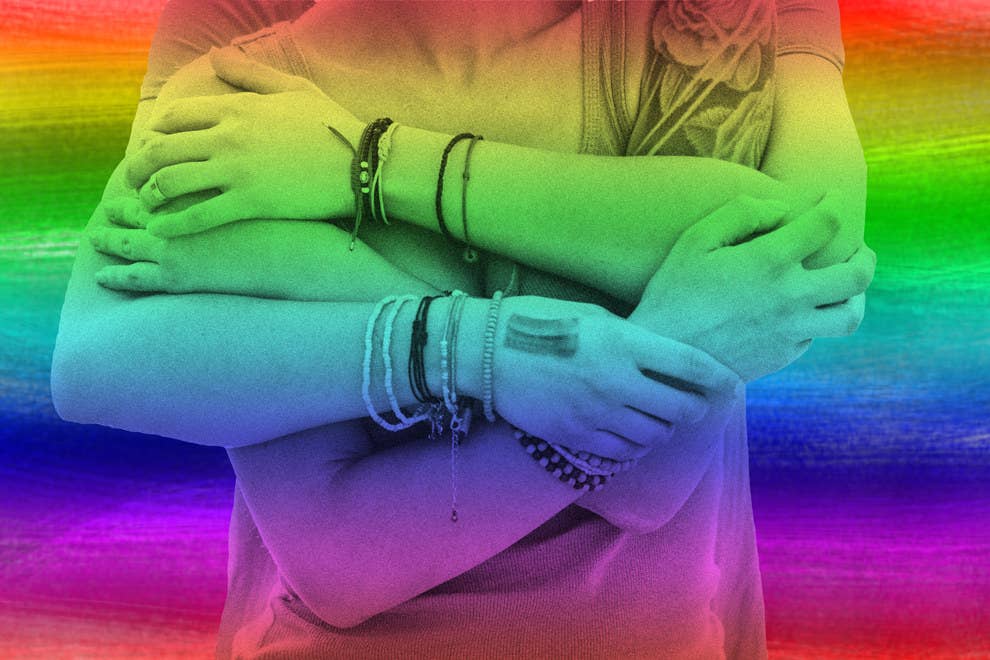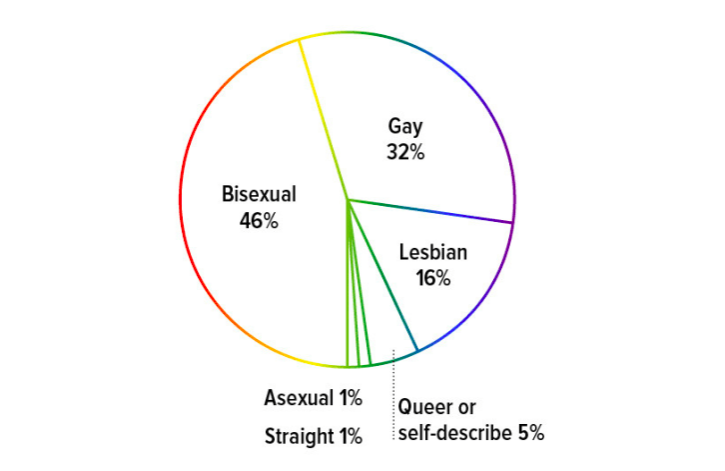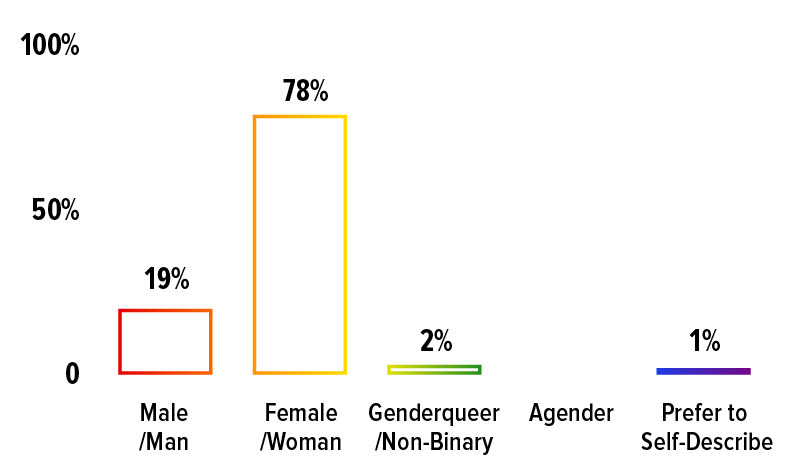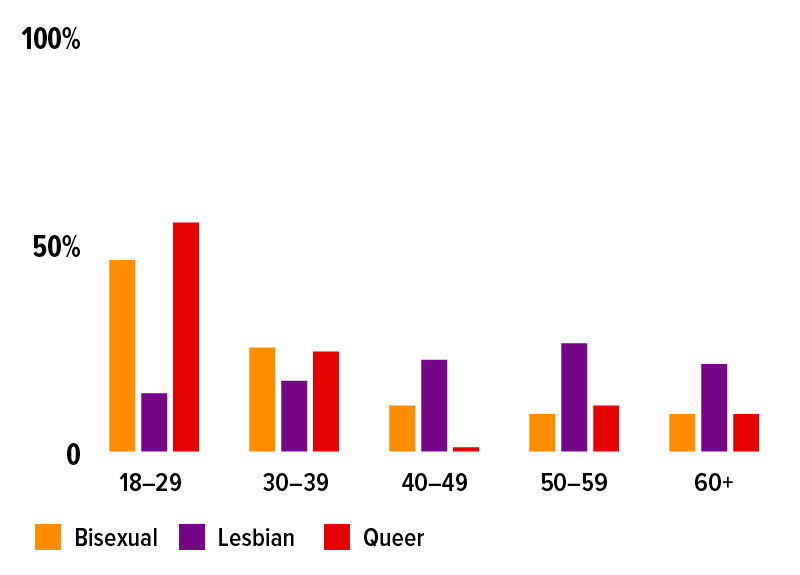
Just over half of LGBTQ people in the United States identify as bisexual or queer — and the overwhelming majority of them are young women. Meanwhile, relatively few young women identify as lesbians.
That’s according to a new survey conducted by Whitman Insight Strategies and BuzzFeed News, taken by 880 LGBTQ Americans across the country. The survey, one of the most comprehensive of its kind, found that 46% of LGBTQ Americans identify as bisexual and 5% identify as queer or prefer to self-describe. (The margin of error overall is plus or minus 3.3%.)
Bisexual women outnumbered bisexual men four to one — 78% to 19%. Three percent said they are genderqueer, nonbinary, or prefer to self-describe.
Sexual orientation of LGBTQ Americans

Nearly half of this group is between the ages of 18 and 29 — 46% of them. Thirty-eight percent of bisexual Americans are also nonwhite, greater than the number of gay or lesbian respondents of color (24% and 26%, respectively). Those who identify as queer are 40% nonwhite.
Although young, bisexual women of color make up a large portion of the LGBTQ American population, they aren’t necessarily reflected in popular cultural conceptions of LGBTQ people, which still tend to be dominated primarily by white gay men and women.
Speaking of gay men and women — twice as many people identify as gay than lesbian (32% to 16%). And while bisexual women tend to be younger, lesbians are the opposite: Only 14% are between the ages of 18 and 29. Sixty-nine percent of lesbians are 40 and older, while only 29% of bisexual people are in the same age range. Twenty-one percent of lesbians are 60 and above, compared to just 9% of bisexuals. (Gay men also skew slightly younger, though with a more even distribution across age ranges.)
Gender identity of bisexual Americans

The majority of those who identified their sexual orientation as queer are also young — 55% are between 18 and 29 — and either female (39%), genderqueer/nonbinary (31%), agender (11%), or prefer to self-describe (9%).
These results are in line with previously reported trends regarding younger generations and sexual identity: Millennials and Gen Z'ers are more likely to identify as queer, no labels, or not 100% straight. LGBTQ people are more likely to be female in general (55% women, 41% men, and 4% nonbinary), and women, in particular, have long been presumed to consider themselves more sexually fluid — which this new data seems to confirm. What the survey also makes clear, however, is that while young women are now more likely to identify as queer or bisexual, they’re much less likely to identify as lesbians.
There are many potential reasons why. One is that, for some young queer people, labels like “gay” or “lesbian,” which imply binary-gender sexual orientations, can seem stale and old-fashioned in a world where we’ve begun to think beyond the binary. Young people aren’t only more likely to identify as bisexual, queer, fluid, or otherwise open to multiple genders — they’re more likely to identify outside of the gender binary themselves. For some assigned-female queer people, identifying as a lesbian might not make sense when their potential dating pool could include not only cis women, but trans women, nonbinary people, and transmasculine people. In short: For some, “lesbian” is not inclusive enough (though there are also self-identified lesbians who date beyond the binary, and are expanding the potential for what their identity can mean).
But that doesn’t explain why young men haven’t been identifying as queer, bisexual, or fluid at similarly high rates. Some of that might be simply due to phallocentrism. While bisexual women are often stereotyped as sleeping with women for male attention, or just going through a phase en route to permanent heterosexuality, the opposite is presumed of bisexual men: that they are simply confused or semi-closeted gay men. Plus: Gay men have a certain kind of cultural cache that lesbians and bisexual people do not and never have; some of the disparities in identity could be attributed to things like the denigration and disappearance of lesbian culture and plain old misogyny (internalized and otherwise).
Age of bisexual, lesbian, and queer Americans

Because of the stigmas and stereotypes associated with bisexual people, there are likely many men who identify as gay who might quietly think they are a couple notches lower on the Kinsey scale. It's also possible that some bisexual men weren't counted in the survey at all, effectively screening themselves out by saying they were straight. Similarly, some (though certainly not all) women who identify as bisexual or even straight may want to sleep with mostly or exclusively women.
These stereotypes are also likely the reason why both bisexual men and women are less likely to be out. Seventy-three percent of gay men and 82% of lesbians say they have fully come out, while only 36% of bisexual people have. Bisexuals are most likely to have come out only in limited contexts (53%), the highest number across all groups.
That disparity could be partly explained by some of the answers to one of the survey’s open-ended questions: “In your own words, what does it mean to you personally to be LGBTQ?” One respondent, a 34-year-old bisexual woman in Tennessee, said, “Sadly, for me it means being ‘in the closet’ because I only realized I was bisexual after I was already married.” Another, a 28-year-old bisexual woman in West Virginia, said, “I am not necessarily PROUD to be bisexual, but I don't hide it if I'm asked.” And a 51-year-old bisexual woman in Virginia said, “I am conflicted. I feel it is wrong but I still want to have sex with women.”
Though bisexual women make up such a large part of the LGBTQ American population, they are understudied, sidelined, and stigmatized, which could account for some of the health disparities also revealed in the poll. Twenty percent of bisexual women rated their mental health as “poor” — the highest among all groups. And while rates of various mental health issues were worryingly high across all subsets of LGBTQ people, bisexual people had some of the highest rates: 70% of bisexual people say they’ve experienced depression, a little over half have experienced anxiety or panic disorders, and a third have self-injured or attempted suicide. ●
METHODOLOGY: Whitman Insight Strategies fielded an online quantitative survey among 880 self-identifying LGBTQ Americans through Research Now. Field dates were from May 24 to June 1, 2018. Respondents were screened to determine sex assigned at birth, gender identity, transgender identification, and orientation to appropriately define the audience. The makeup of the N=880 Self-Identified LGBTQ Americans includes 265 Gay (30%), 129 Lesbian (15%), 403 Bisexual (46%), 51 Transgender (6%), and 74 Queer, Nonbinary (8%) individuals.
The margin of error at the 95% level of confidence for the total sample is ± 3.3% and is slightly larger for any findings among the individual LGBTQ audiences.
